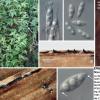
12-01-2026 05:24
 Danny Newman
Danny Newman
Cyathicula coronata on Urtica dioicaCataloochee Di

11-01-2026 20:35
Hello.A very tiny pyrenomycete sprouting sparsely

15-12-2025 11:49
 Danny Newman
Danny Newman
ITS sequences from the following two collections B

09-01-2026 17:41
Arnold BüschlenHallo, F. dilatata wird von vielen Bryoparasiten

10-01-2026 20:00
Tom SchrierHi all,We found picnidia on Protoparmeliopsis mur

07-01-2026 22:22
 Danny Newman
Danny Newman
Tatraea sp. on indet. hardwood The Swag, Great Sm

10-01-2026 01:18
 Danny Newman
Danny Newman
cf. Neovaginatispora fuckelii on indet. shrub Pre

07-01-2026 10:24
 Danny Newman
Danny Newman
Pezicula sp. on indet. hardwood Appalachian Highl

09-01-2026 10:08
 Blasco Rafael
Blasco Rafael
Hola, en el mismo habitat que la anteriorRetamaDia

08-01-2026 21:22
 Blasco Rafael
Blasco Rafael
Hola, He recogido esta muestra de Orbilia sobre Re
Diaporthe trinucleata - rare or overlooked?
Chris Yeates,
21-07-2021 20:01

Bonsoir tous
I recently collected some dead stems of Eupatorium cannabinum with the purpose of producing a composite image of Plenodomus agnitus (= Leptosphaeria agnita) which is common on that host in this area.
I noticed that among the numerous pseudothecia of that fungus there were much scarcer smaller fruitbodies mostly immersed in the host plant's cortex, and with pointed necks very different from the shallowly domed Plenodomus. From the apical ascal structure it was clear that this a member of the Diaporthales, and probably a member of the Diaporthaceae.
Having recently written up the Diaporthales for an ongoing Yorkshire Mycota I fully appreciate the nomenclatural and taxonomic issues with that order and might well have moved on. However there were a couple of interesting features: one was the complete lack of a septum, which pointed to what would at one time have suggested a member of Diaporthopsis (now sunk into Diaporthe), and the other was the high proportion (>90%) of spores containing three large guttules. Searching through Munk (1957) and Wehmeyer (1933) indicated that there was such a species and that it was a Eupatorium specialist - Diaporthe trinucleata Niessl. So I am quite happy to use that name for this collection, although I appreciate that sequencing might in future shed more light on this. Of interest is that on a few of the spores a hyaline conical appendage at each end of the spore could just be made out - easier to see than to photograph! Munk mentions no such feature and Wehmeyer specifically states he didn't see it, but Niessl in his protologue mentions "...utrinque obtusiusculis breve mucronatis hyalinis...".
I shall certainly keep an eye out for this taxon on further encounters with Eupatorium, and wondered whether anyone else had found it?
Cordialement, Chris
Thomas Læssøe,
21-07-2021 20:58
Re : Diaporthe trinucleata - rare or overlooked?
I have made two Danish records on this species on that host (no notes available on the database, maybe with the material)
cheers
Thomas
cheers
Thomas
Chris Yeates,
23-07-2021 14:18

Re : Diaporthe trinucleata - rare or overlooked?
Thanks for that Thomas. So the host relationship seems consistent - do you find Plenodomus agnitus to be rather common on Eupatorium in Denmark as well?
kind regards, Chris
